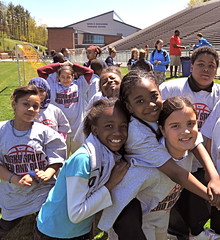
Neag kinesiology professor Jennie Bruening knows what the late Jaime Escalante, the math teacher who inspired the film “Stand and Deliver,” and Geoffrey Canada, founder of the Harlem Children’s Zone, both know: Low academic performance in deprived communities can’t be chalked up to the kids.
So, Bruening, inspired by Whatever It Takes, a book about the Harlem project, started drawing together like-minded people in Hartford to talk about creating a zone there. She has organized about 60 activists and local leaders who are compiling data about existing programs, demographics and needs with the hope of procuring one of President Obama’s Promise Neighborhood grants.
“I didn’t know about the Harlem Children’s Zone until about two years ago,” Bruening says about the holistic approach to rebuilding a community so that its children can stay on track through college and go on to the job market. But when she read the book, she thought, “Wow, doesn’t this make sense.” She and other organizers represented Hartford at the “Changing the Odds” conference sponsored by the Harlem Zone last year and returned in January with a larger group of Hartford and UConn representatives to visit the 97-block project.
Daryl Rock, superintendent of the Promise Academies in the Harlem Children’s Zone and a University of Hartford graduate, says Bruening and her group have a good energy. “There are a lot of Harlems throughout the country where people in those communities are not doing well in school and wind up in the criminal justice system,” Rock says. “If they get the right adults to implement it, it can work.”
For Bruening, this recent labor is a natural offshoot of her Husky Sport program in Hartford’s North End. Since 2003, she and her students have been going there to be mentors to kids at an elementary school, a recreation center and a Saturday program at the Catholic Worker House. Their mission is to help kids find balance by way of nutrition, education, life skills, sports and physical activity.
“I’m not trying to say that Husky Sport is anything near to what’s going on in Harlem, but it’s parallel thought,” Bruening says.
Longtime neighborhood leaders see Bruening as a perfect fit to get the Hartford project off the ground. “First of all she’s got moxie, compassion, drive,” says Chris Doucot, a North End stalwart who runs the Catholic Worker House with his wife Jackie Allen-Doucot. “She’s level-headed. I think it took somebody who is not a part of Hartford’s past to get the ball rolling on this. She wasn’t mired in the rivalries and the tit for tats. She stands outside that.”

The Husky Sport focus is not a one-shot deal. Students see the kids six days a week and are often greeted with hugs. “Anyone who’s from UConn has an instant in,” Bruening says. “And then you have to prove yourself from there.”
And prove themselves, they do. Students often stay beyond their undergrad years in the field of kinesiology and grow in the program, she says.
Beryl Bailey, director of preK-5 literacy in the Hartford schools, calls Bruening’s UConn students experts in urban education. “She’s mentoring them in the lessons of life that you really can’t get in a college classroom. She provides more than that education they’re paying for,” Bailey says.
Plus, Bailey learned something herself from Bruening’s Husky Sport message to students at Clark School, where Bailey was principal. “She won me over on recess because I thought our kids played too much. They need to sit and read. But that physical activity provides blood to the brain, I got that from Jennie.”
Bruening came to UConn’s Sport Management program in 2002 and directs its laboratory. She is also a fellow with Northeastern University’s Center for the Study of Sport in Society, where she is spending her sabbatical this semester.
Once a part of the city is chosen to beta test the zone project, a community organization will take the lead, she says. “I’m the one pulling all the people together, but I’m not going to be the face of all this.”
Lee Hunt, who is working with Bruening and is executive director of the Blue Hills Civic Association, says that decision is key. “Whoever would be that lead organization, that would be their calling. So they need to be seriously invested in the community and willing to be imbedded in this community.”
With the city’s political past, its divisions and its 30 percent poverty level, the climb will be steep, the organizers agree. So, they are gauging the successful programs and service providers already in place and planning to build on those to create the holistic neighborhood renewal.
“The kids are the link into the family, but the whole family becomes part of the zone,” Bruening says.

In March, Bruening met with faculty and students in the Neag School about a long-term role in the project, drawing on its strengths in research, evaluation, student teaching, outreach, enrichment and learning programs, while factoring in the challenge of academic cycles. She called it an opportunity to be a group partner vs. offering a fragmented approach, a chance to build on how UConn already serves the Hartford community.
About 20 Promise Neighborhood grants will award $500,000, with a $500,000 match required from local sources, for start-up planning. But even if they don’t get the federal money this round, the group is committed to making the Hartford Promise Neighborhood idea happen.
“This isn’t something political that’s going to make someone’s reputation. This is a legitimate chance to change some things that are desperately wrong and unfair,” Bruening says.
 Facebook
Facebook
 Twitter
Twitter
 LinkedIn
LinkedIn
